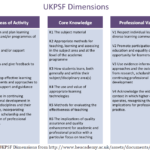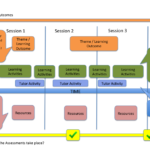At the end of the second day of CAIeRO, we hope you will feel like you’ve achieved a lot! But we know from experience that you will probably also feel like you have a lot still to do. This is why the last two stages of the CAIeRO process are important.
Action planning
 While all your ideas are fresh in your minds (and ideally while all your team are still together in the room), it’s a good idea to agree on an action plan for the work you didn’t manage to do during the CAIeRO. This might include completing the learning activities for the modules you’ve been working on, reviewing and aligning other modules on the programme, completing quality assurance processes such as change of approval, and further training or development for you and your team. If you have a deadline to complete the work, like a planned start date for a new course or module, start from there and work backwards to determine when you need to complete each step. It’s important to lay out all the steps you need to take, and to put dates and names against them so that you don’t lose momentum. Identify ‘owners’ for each task but also anyone who can help – there will always be other work to do, but shared deadlines can help to make sure you fit in what you’ve agreed to do.
While all your ideas are fresh in your minds (and ideally while all your team are still together in the room), it’s a good idea to agree on an action plan for the work you didn’t manage to do during the CAIeRO. This might include completing the learning activities for the modules you’ve been working on, reviewing and aligning other modules on the programme, completing quality assurance processes such as change of approval, and further training or development for you and your team. If you have a deadline to complete the work, like a planned start date for a new course or module, start from there and work backwards to determine when you need to complete each step. It’s important to lay out all the steps you need to take, and to put dates and names against them so that you don’t lose momentum. Identify ‘owners’ for each task but also anyone who can help – there will always be other work to do, but shared deadlines can help to make sure you fit in what you’ve agreed to do.
At this point, while you have diaries to hand, you should schedule a follow up meeting to review progress. This will allow you to keep each other on track and keep the modules closely aligned, and it will also allow you to adjust if any changes come up in the meantime. Remember your Learning Designer and Learning Technologist are there to help you throughout the whole journey of design into delivery, and they will be keen to get feedback on what has (and has not) worked well for you and your team, as well as what works well with the students when you start to deliver the module(s). This helps us to get a clear idea of how much work is still to be done, and to schedule support accordingly, but also to shape our support and guidance for future CAIeROs.
Reflecting on CAIeRO
We hope that the CAIeRO process will help you build your course design skills, as well as building a better module. At each stage of the CAIeRO, your learning designer will try to make explicit the principles informing each task, and help you think about how to transfer the work you’re doing to other areas. If you have time at the end of the CAIeRO workshop, you might allow 15 minutes or so for reflection, and try to capture the discussions you’ve had and the reasons behind the changes and choices you’ve made. This will not only be useful when you come to deliver the module, but also when you are thinking about your own professional development as an educator.
We’d love to hear your reflections on the CAIeRO process, and any feedback that might help us improve. If you’d like to tell us about it, drop us an email at LD@northampton.ac.uk.
This is one in a series of posts about the CAIeRO process. To see the full list, go the original post: De-mystifying the CAIeRO.
Need a CAIeRO? Email the Learning Design team at LD@northampton.ac.uk.
Stage 3 of the CAIeRO process usually begins at the start of the second day. By this stage you should have your blueprint and storyboard finalised, and a clear vision of your new module design(s). The next step is to start making your ideas more concrete, by creating the learning and teaching activities that will support students to reach the learning outcomes.
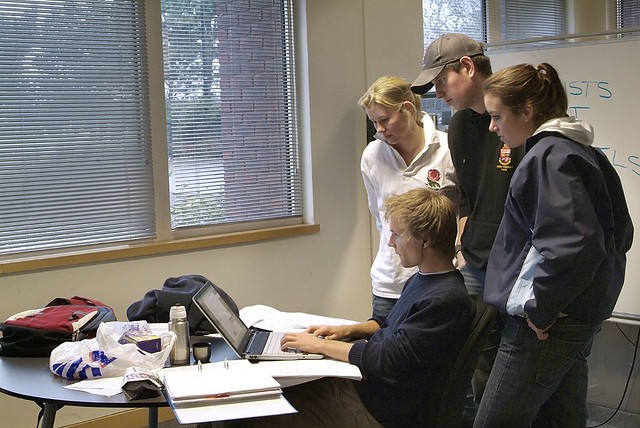 On your storyboard, you will have a number of placeholders along the learning journey where students need to learn particular things. Pick one of these to start with, and think about what kind of learning activities might help the students to get to grips with it. Is it a new concept or skill, where they will need some initial information or a demonstration from you (or someone else) to get started? Is it a complex idea or skill they will need some time to explore? Is there an opportunity to let them apply it, through experimentation or practice? Is it an area where they might benefit from sharing knowledge or experience, or being exposed to different perspectives through debate? You might find the Hybrid Learning Model cards helpful here, as they list verbs describing what the tutor and the student can do to support different types of learning.
On your storyboard, you will have a number of placeholders along the learning journey where students need to learn particular things. Pick one of these to start with, and think about what kind of learning activities might help the students to get to grips with it. Is it a new concept or skill, where they will need some initial information or a demonstration from you (or someone else) to get started? Is it a complex idea or skill they will need some time to explore? Is there an opportunity to let them apply it, through experimentation or practice? Is it an area where they might benefit from sharing knowledge or experience, or being exposed to different perspectives through debate? You might find the Hybrid Learning Model cards helpful here, as they list verbs describing what the tutor and the student can do to support different types of learning.
Creating learning activities
This section of the workshop is sometimes thought of as the ‘e-tivity bit’, but it’s important not to think too much about the technology to start with. Think about the type of activity you think would work best. If you or your colleagues have taught that subject before, what worked well? Once you know what you’d like the students to be doing, then think about the context – is this something that needs to happen in the classroom or outside? Technology can add possibilities and allow us to design learning experiences that weren’t possible in the past – think about linking up live with an expert in the field, or providing your students with world-class open educational resources. It’s also important to make sure that your students are exposed to digital learning practices, and develop the skills they will need to keep learning beyond their degree. But online is not always the best mode for every activity, so if you have face to face time with your students, make sure you use it wisely!
To help you figure out the best context for each activity, it’s important to be aware of the strengths and weaknesses of the tools available to you. Your Learning Technologist can help you with this, and you may also be able to get advice from your colleagues on their experiences. Don’t be afraid to talk about things that haven’t worked well – it may be that there are new tools or skills that could help you tweak that activity so that it works better next time, and part of the aim of the CAIeRO is to develop your skills as well as your module!
This is why we will ask you to create at least one online learning activity in the learning environment (NILE) as part of the workshop. You can take advantage of all the skills in the room, and you’ll leave with something real that you can use in your teaching! If you wish, you can use the e-tivity template, which embeds some key principles for online learning activities, including having a clear purpose, active learning tasks and opportunities for reflection and feedback. Or if you prefer, you can design your own.The reality check
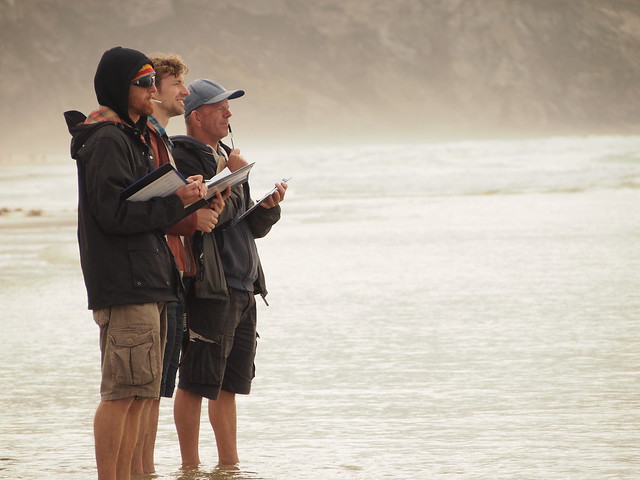 Once you have some learning activities created in NILE, it’s time to take a break while your reality checkers look them over. Reality checkers will ideally be students, but can also be colleagues, externals, anyone who has not been involved in the design of the module so far. Remember too that they don’t have to be in the room, they just need to be able to access the learning environment! The purpose of this stage of the workshop is to get an objective view of what you have created, and to provide constructive feedback to help you improve it. It’s important that you resist the urge to ‘help’ or ‘explain’ things to your reality checkers – remember when your real students come to this activity, they may not be able to call you and ask for clarification! Ideally your activity should stand by itself, with clear instructions allowing anyone who hasn’t seen it before to understand the purpose and how to complete it.
Once you have some learning activities created in NILE, it’s time to take a break while your reality checkers look them over. Reality checkers will ideally be students, but can also be colleagues, externals, anyone who has not been involved in the design of the module so far. Remember too that they don’t have to be in the room, they just need to be able to access the learning environment! The purpose of this stage of the workshop is to get an objective view of what you have created, and to provide constructive feedback to help you improve it. It’s important that you resist the urge to ‘help’ or ‘explain’ things to your reality checkers – remember when your real students come to this activity, they may not be able to call you and ask for clarification! Ideally your activity should stand by itself, with clear instructions allowing anyone who hasn’t seen it before to understand the purpose and how to complete it.
Your reality checkers will complete a feedback form that you can refer back to afterwards. You may also want to ask them to run through their thoughts on the activities, to get some more detail (if they are not in the room you could do this using Collaborate or Skype).
Review and adjust
Once your reality checkers have left, it’s a good idea to take a short amount of time to do some adjustments based on their feedback, while it’s fresh in your mind. Then you’re almost done!
This is one in a series of posts about the CAIeRO process. To see the full list, go the original post: De-mystifying the CAIeRO.
Need a CAIeRO? Email the Learning Design team at LD@northampton.ac.uk.
Bob has always taught his module using a traditional lecture-seminar format. He wants to bring in some new ideas, but doesn’t have much time to read up on pedagogic research. In the CAIeRO, he is teamed up with Joe and Laura. Joe is a new member of staff from a distance learning institution, who uses a lot of open educational resources to support his students in independent study. Laura leads another module on the programme, where she has been trialling peer teaching and problem based approaches. They spend some time discussing, sharing and planning. At the end of the session Bob’s storyboard for the module looks very different…*
In the context of CAIeRO, a ‘storyboard’ is a visual plan of your module from beginning to end. Once you have the blueprint of the module agreed, the next step is to figure out how to deliver that in practice. This is sometimes the most challenging part of the CAIeRO process, but it can also be where the magic happens – where a new vision for the module starts to become a reality.
The main aims of the storyboarding task are around sequencing, alignment and coherence. These can be achieved through mapping out the themes, learning activities and assessment items – what students need to know, how they will learn it, and how they will show that they have learned it (that constructive alignment idea again!). The idea is to create a logical sequence of activity, or learning journey, that allows the learner to build knowledge, skills and understanding so that these can be demonstrated through assessment. We’ll then go on to consider in detail how that learning might happen, and what kinds of activities can be put in place to support it.
 You will be asked to note down all of the broad themes that students on the module will need to learn about – the big concepts, the core skills, everything they’ll need to learn to reach the outcomes you’ve written – and to put them in some sort of sequence. This is a fun activity involving lots of post-it notes and flip chart paper, allowing things to be moved around and re-arranged as needed. The trick with storyboarding is to approach it from the perspective of the learner. Resist the temptation to replicate the way you deliver the module now – in week 1 I do this, in week 2 I do this… Instead, ask yourself: if I were a student coming to this for the first time, what would I need to learn first?
You will be asked to note down all of the broad themes that students on the module will need to learn about – the big concepts, the core skills, everything they’ll need to learn to reach the outcomes you’ve written – and to put them in some sort of sequence. This is a fun activity involving lots of post-it notes and flip chart paper, allowing things to be moved around and re-arranged as needed. The trick with storyboarding is to approach it from the perspective of the learner. Resist the temptation to replicate the way you deliver the module now – in week 1 I do this, in week 2 I do this… Instead, ask yourself: if I were a student coming to this for the first time, what would I need to learn first?
Start adding your post-its to the timeline – they need to learn about this, they need to learn how to do that – start with broad headings, and then break these down in to more detailed subheadings (these will be your learning activities). While you’re doing this, it’s also helpful to note down any relevant learning resources you have created or found (texts, videos, even expert speakers!). We’ll need these in the next section of the workshop. You might find you have more learning activities specified for introductory level 4 modules, where students might benefit from having more structure, and less for modules that are more student-led or involve more independent study. That’s fine, but if you’re unsure, you can do a quick ‘sense check’ back to your look and feel cards. Did you specify how much guidance you thought was appropriate? Are you sticking to that, or has your thinking changed?
Once you have a rough sequence for the learning activities, place your summative assessment activities on the timeline (usually using a different colour post-it). Here are some more ‘sense checks’. Are you covering all of the knowledge and skills needed for that assessment before it happens? If not, you need to move things around – or reconsider what’s being assessed at that point. Don’t worry if your blueprint changes as a result of storyboarding. CAIeRO is a dynamic process and nothing is set in stone! You should also check at this point that your learning activities plan includes opportunities to learn the skills required for the assessment, and to try these out formatively.
At this point you should be starting to get a sense of how the workload looks. Some areas of learning will be bigger than others. Some will cross over, and you may need to move things around. At this point there are two ‘sense checks’ to do. The first is around workload for the learner. Can you space out the activities evenly so that the workload is balanced? Do you know what’s happening in other modules that run alongside this? Think about how the student will experience the plan you are putting in place. This leads in to the second sense check: Where on the timeline will the students most need access to you?There is no right answer to this question; it will vary according to the subject, level and cohort, and you will also have to consider the constraints of your own workload, timetabling and so on. The important thing is to plan contact time that will have the most impact for learning. You might have one aspect of the module that students find particularly difficult, and choose to spend a substantial amount of contact time at that point to make sure students can progress. You might have the first module in the first year of a programme, and decide that weekly clarification sessions are important to make sure students are on track. You might have a distance cohort on different time zones, and decide that the best support you can provide is in frequent monitoring of discussions or online ‘office hours’ sessions. Whatever you decide, the CAIeRO process will help you work through the options – and the final storyboard can be digitised as a useful visual to help students understand your chosen approach.
If you’re doing a standard two day CAIeRO, ideally you will have a (mostly) completed storyboard for your module by the end of day 1. It’s a good idea to pause and reflect at this point, but it’s also important not to lose momentum. Once your outline is finalised, the next step is to start creating the learning activities.
This is one in a series of posts about the CAIeRO process. To see the full list, go the original post: De-mystifying the CAIeRO.
Need a CAIeRO? Email the Learning Design team at LD@northampton.ac.uk.
*All characters are fictional representations. ‘Bob’ and ‘Laura’ were inspired by Alex Bruton’s post on the Flipped Academic – worth a read if you have a little more time to spare…
 Having redesigned her Leading Public Health Practice module from being fully face-to-face, to blended, Sue Everett in the School of Health, reflects on the skills she developed in the process and how she has moved from being a ‘technophobe’ to the ‘go to’ girl for technology in her office!
Having redesigned her Leading Public Health Practice module from being fully face-to-face, to blended, Sue Everett in the School of Health, reflects on the skills she developed in the process and how she has moved from being a ‘technophobe’ to the ‘go to’ girl for technology in her office!
If you have any questions about CAIeRO, or would like to book one for your module team, please email LD@northampton.ac.uk. If you would like to talk further to Sue about her experiences, she is happy for you to contact her.
 In March/April 2014, Sue Everett, Kirsty Mason and Stuart Allen in the School of Helath underwent a CAIeRO on their three modules for the PGC in Public Health. Initially redesigned for fully online learning, the Programme was slightly altered to reintroduce some face-to-face sessions, resulting in a ‘Waterside-ready’, set of blended learning modules.
In March/April 2014, Sue Everett, Kirsty Mason and Stuart Allen in the School of Helath underwent a CAIeRO on their three modules for the PGC in Public Health. Initially redesigned for fully online learning, the Programme was slightly altered to reintroduce some face-to-face sessions, resulting in a ‘Waterside-ready’, set of blended learning modules.
Having run her module in the new design, Sue shares some of her reflections on the process and her learning experiences in this video.
If you have any questions about CAIeRO, or would like to book one for your module team, please email LD@northampton.ac.uk. If you would like to talk further to Sue about her experiences, she is happy for you to contact her.
At recent events, including last week’s Learning and Teaching conference, the Learning Design team have been trying out some new activities to help teaching staff think about how they design for learning. You may have seen some of these new tools and activities described in earlier posts in this category, or had the chance to have a go at using them in development events. In this post I’d like to look at the bigger picture of how these might fit together with some of the other services we offer.
At the conference, we hosted a ‘cracker barrel’ table. The staff that came to see us were offered giant post-its (no small motivation!) in exchange for drawing us a picture of what they value most in their teaching. You can view these in our online album here (we’ll be adding more from other events to this album too):
 |
| What I value most in teaching |
The resulting images were not just works of art. They could also be seen as ‘teaching metaphors’ (McShane 2005). We asked participants to expand on these, and break down what was happening in the image using three key questions:
- what is the role of the tutor?
- what is the role of the student?
- what is the role of technology?
Common themes in the role of the tutor included motivation, guidance, facilitation and enabling, linking learners together and lighting ‘sparks’ and ‘light bulbs’ of understanding. There was also an emphasis on pastoral roles, being ‘approachable’, ’empathetic’ and a ‘confidant’. The role of the student was widely agreed to be participative, with comments noting the importance of engaging, contributing and becoming autonomous. Some comments also noted that the distinction between tutor and student is not so dichotomous, and that learning happens in a community where the participants all learn together. Comments on the role of technology mostly focused on supporting access to learning, as well as ‘fostering community’ and enabling sharing. You can see all the contributions in this PDF file (3.5MB, captured using the Post-It Plus app).
 Sadly that was all we had time for on the day, but we did ask them to go away and think about how their image related to their own programmes and modules. Is that ideal teaching moment what’s happening in those modules now? And if not, what could they change that might enable them to do more of what they value?
Sadly that was all we had time for on the day, but we did ask them to go away and think about how their image related to their own programmes and modules. Is that ideal teaching moment what’s happening in those modules now? And if not, what could they change that might enable them to do more of what they value?
This led me to think about a model that I had been introduced to by our very own Deborah Forbes, in a staff development session on Thriving in a Changing Environment*. The model is Appreciative Inquiry (AI), and as a positive approach to change management it has a lot to offer as we prepare for Waterside. Here’s what some of the experts have to say about AI:
“The traditional approach to change is to look for the problem, do a diagnosis, and find a solution. The primary focus is on what is wrong or broken …Appreciative Inquiry suggests that we look for what works in an organization …Because the statements are grounded in real experience and history, people know how to repeat their success.” (Hammond, 1998, pp.6-7)
And:
“[Appreciative Inquiry] deliberately seeks to discover people’s exceptionality – their unique gifts, strengths, and qualities. It actively searches and recognizes people for their specialties – their essential contributions and achievements. And it is based on principles of equality of voice – everyone is asked to speak about their vision of the true, the good, and the possible.” (Cooperrider, 2001, p.12)
Although there is no one definitive model for AI, the 4-D aproach is widely used. This consists of four main steps:
- Discover: The identification of organisational processes that work well.
- Dream: The envisioning of processes that would work well in the future.
- Design: Planning and prioritising processes that would work well.
- Destiny: The implementation (execution) of the proposed design. (Cooperrider and Whitney, 2005, p.17)
In terms of programme and module design, the steps we covered at the conference were targeted at the ‘discover’ and ‘dream’ stages – by helping staff to think about what works really well for them and their students, they can begin to think about what their programme or module might look like if they did more of it. This begins a process that then feeds in to the beginning of the CAIeRO, where staff are asked to outline their aims for the programme or module, create a mission statement for it, and think about the ‘look and feel’ (see this post for more on this). The CAIeRO process then leads the course team through the ‘design’ stage towards the ‘destiny’ or delivery of the new or re-designed modules.
Do you have positive stories to share about what you love about teaching, what’s working well, and what it should look like in the future? Would you like to contribute to the conversation? Then why not add your comments, send us a picture (along with a brief outline of what’s happening), or write us a case study? You can comment on this post, or email the Learning Design team at LD@northampton.ac.uk.
References:
Cooperrider, D.L. (2001) Why Appreciative Inquiry? In Cooperrider, D.L., Hammond, S. and Royal, C. (eds) Lessons from the Field: Applying Appreciative Inquiry. Plano: The Thin Book Publishing Company.
Cooperrider, D.L. and Whitney, D (2005) Appreciative Inquiry: A positive revolution in change. San Francisco: Berrett-Koehler.
Hammond, S. (1998) The Thin Book of Appreciative Inquiry. Plano: The Thin Book Publishing Company.
McShane, K. (2005) Metaphors for University Teaching. Learning and Teaching in Action. 4(1). Available from: http://www.celt.mmu.ac.uk/ltia/issue10/mcshane.shtml [Accessed 29th May 2015]
* Look out for future sessions on the Staff Development site on NILE (note, you will need to be logged in to NILE for this link to work).
Q: How do you eat an elephant?
A: One bite at a time!
 The move to Waterside can seem as if it isn’t really that long away, given all that you may feel you have to do inbetween now and then. Wondering where to start can also seem daunting and the mountain of work that you see ahead of you can be so huge that you can’t even see the summit, let alone work out a route to the top.
The move to Waterside can seem as if it isn’t really that long away, given all that you may feel you have to do inbetween now and then. Wondering where to start can also seem daunting and the mountain of work that you see ahead of you can be so huge that you can’t even see the summit, let alone work out a route to the top.
In supporting staff to get to grips with the course redesign implications that are predicated on a number of guiding principles about how learning and teaching will look, the Learning Design team came across a really useful set of blog posts by Tony Bates, a Canadian Research Associate who is also President and CEO of Tony Bates Associates Ltd and who, according to their website are “a private company specializing in consultancy and training in the planning and management of e-learning and distance education.”
The blog posts were written to help people understand and implement a series of practical steps to help deliver quality in their online learning materials. While I don’t wish to duplicate the posts here, I thought it might be helpful to summarise some of the key points in an attempt to help you to start thinking about how you might begin to eat your own elephant, or climb that mountain. I found some obvious points in the posts, some practical and straightforward suggestions and some real gems. There are also some questions and exercises to get you started along the road to redesigning your own modules.
I should also preface this post with the reminders that, as an institution, we are definitely NOT going fully online but will be exploring ways to enhance our learning and teaching using technology and that the precise nature of each blended module is for staff teams to determine.
The Nine Steps are as follows (each link will take you straight to the original post)
- Step 1: Decide how you want to teach online
- Step 2: Decide on what kind of online course
- Step 3: Work in a Team
- Step 4: Build on existing resources
- Step 5: Master the technology
- Step 6: Set appropriate learning goals
- Step 7: Design course structure and learning activities
- Step 8: Communicate, communicate, communicate
- Step 9: Evaluate and innovate
Step 1: Decide how you want to teach online
 This step highlights the importance of rethinking the way you teach when you go online and redesigning the teaching to meet the needs of your online learners given that their needs may differ because of the specific learning context. The gem in this post is the emphasis on asking you to consider your basic teaching philosophy – what is your role and how would you like to tackle some of the limitations of classroom teaching and renew your overall approach to teaching? As Bates himself says: “It may not mean doing everything online, but focussing the campus experience on what can only be done on campus.”
This step highlights the importance of rethinking the way you teach when you go online and redesigning the teaching to meet the needs of your online learners given that their needs may differ because of the specific learning context. The gem in this post is the emphasis on asking you to consider your basic teaching philosophy – what is your role and how would you like to tackle some of the limitations of classroom teaching and renew your overall approach to teaching? As Bates himself says: “It may not mean doing everything online, but focussing the campus experience on what can only be done on campus.”
Step 2: Decide on what kind of online course
 Bates describes a continuum of online learning ranging from online classroom aids to fully online and explores four key factors that will influence the kind of online course you should be teaching:
Bates describes a continuum of online learning ranging from online classroom aids to fully online and explores four key factors that will influence the kind of online course you should be teaching:
- your teaching philosophy (see step 1)
- the kind of students you are trying to reach (or will have to teach)
- the requirements of the subject discipline
- the resources available to you
A number of subject groups and disciplines are already starting to explore what the current direction of travel for learning and teaching at Northampton might look like for them and developing models and suggestions for how to redesign their modules and programmes within a broader set of principles. It is useful to note that while Bates experience suggests that “almost anything can be effectively taught online, given enough time and money” (emphasis added), the reality is that resources are finite and that it is therefore imperative to work out what could and should be taught face-to-face and what could and should be taught online, remembering that we are still going to be primarily a campus-based institution. He begins the process by differentiating between the teaching of content and the teaching or development of skills and provides a useful example of how this might look in practice.
The gem here is his consideration of how to make best use of the various resources available to you including time (the most precious resource of all), your learning technology support staff (always glad to help), your VLE (NILE) and your colleagues.
Step 3: Work in a Team
 Online learning is different to classroom teaching and as a result will require staff to learn some new skills. You are unlikely to have all your F2F learning materials in a suitable format for online learning. This post considers how the team of staff around you can help you to move from where you are, to where you want to get to given that “particular attention has to be paid to providing appropriate online activities for students, and to structuring content in ways that facilitate learning in an asynchronous online environment”. Working in a team can also, of course, help with managing the workload, and with getting quickly to a high quality online standard, as well as being a way to save some of your time.
Online learning is different to classroom teaching and as a result will require staff to learn some new skills. You are unlikely to have all your F2F learning materials in a suitable format for online learning. This post considers how the team of staff around you can help you to move from where you are, to where you want to get to given that “particular attention has to be paid to providing appropriate online activities for students, and to structuring content in ways that facilitate learning in an asynchronous online environment”. Working in a team can also, of course, help with managing the workload, and with getting quickly to a high quality online standard, as well as being a way to save some of your time.
Step 4: Build on Existing Resources
As one Deputy Dean said at a recent School Learning and Teaching Development Day: “Let’s not throw the baby out with the bathwater!”
This can include repurposing your own content, but also drawing on existing online resources (TED talks, The Khan Academy, iTunesU) as well as ‘raw’ content that you can use as the basis for developing learning activities and he argues that ‘only in the areas where you have unique, original research that is not yet published, or where you have your own ‘spin’ on content, is it really necessary to create ‘content’ from scratch”.
The hidden gem? Distinguishing between using existing resources that “do not transfer well to an online learning environment (such as a 50 minute recorded lecture), and using materials already specifically developed for online teaching”. He suggests that you “take the time to be properly training in how to use [NILE]”, recognising that a 2-hour investment now can save you hours of time later on.
Step 5: Master the Technology

That’s it really – come to some training on the tools that you would like to use and know more about! This includes learning about their strengths and weaknesses so that you know that you have selected the right tool for the job, but also have a clearer idea about how they might work in practice or how to avoid some of the pitfalls. There are plenty of tools out there, but selecting the right tool is an instructional or pedagogical issue that requires you to be clear on what it is that you are trying to achieve.
Bates’ gem (from my perspective) is his no-nonsense approach to engaging with central training and development initiatives. Here are a few that might help:
- The CLEO (Collaborative Learning Experiences Online) workshop that forms part of our C@N-DO staff development programme is a good way of putting yourself in the shoes of the online learning and experiencing first hand some of the obstacles that online learners face, in order to prevent your own students facing similar issues.
- NILE training (around specific pedagogical purposes) is provided by the Learning Technology team and in addition to regular scheduled training, can also be tailored to suit the purposes of your subject team or discipline. Please just ask!
- Spend a little time each year looking at any of the new features added to NILE during the year (Check out the Learntech Blog for updates).
Finally in this step is a discussion around why simply recording your lectures is not the best way to go. Definitely worth the time to read through his reasons, if this is something you were considering.
Step 6: Set appropriate Learning Goals
 In short, should the learning goals (outcomes) for online/blended learning be the same as, or different to the same module delivered in a fully face-to-face mode? The key differentiator is that while the goals may well remain the same, the method may change. He also raises the question as to whether additional learning outcomes need to be considered in terms of the development of 21st century learning skills (in particular, learning the skills to ‘manage knowledge’ long after they graduate).
In short, should the learning goals (outcomes) for online/blended learning be the same as, or different to the same module delivered in a fully face-to-face mode? The key differentiator is that while the goals may well remain the same, the method may change. He also raises the question as to whether additional learning outcomes need to be considered in terms of the development of 21st century learning skills (in particular, learning the skills to ‘manage knowledge’ long after they graduate).
The link between learning outcomes and assessment is also explored here as is the way in which assessment drives student behaviour. He concludes by saying that “[b]ecause the internet is such a large force in our lives, we need to be sure that we are making the most of its potential in our teaching, even if that means changing somewhat what and how we teach”.
Step 7: Design Course Structure and Learning Activities
After an initial exploration between ‘strong’ and ‘loose’ online learning structures, Bates identifies the three main determinates of teaching structure as being:
- the organisational requirements of the institution;
- the preferred philosophy of teaching of the instructor; and
- the instructor’s perception of the needs of the students.
In the light of recent discussions here around what is meant by ‘contact’ hours (see this Definitions paper produced recently by the University’s Institute of Learning and Teaching), he identifies problems with this approach whilst simultaneously recognising that this is, nevertheless, the standard measuring unit for face-to-face teaching. One reason he highlights in particular is that it measures input, not output. Bates is also keen to ensure parity between online and face-to-face learning in terms of ensuring quality at Validation.
He discusses the time input as well as the structure of modules and how existing face-to-face structures mean we can already be some way down the path on module design, with the important proviso that it is important to ensure that content moved online is suitable for online learning. This is where the Learning Design team can help you to make decisions around what to teach or what to leave out, given that making some work optional means it should not be assessed and that if it is not assessed, students will quickly learn to avoid doing it.
This step concludes with a look at how to design student activities. This is typically something that would be covered during the second day of a CAIeRO curriculum redesign workshop, but anyone who has participated in any part of the C@N-DO programme will already have come into contact with some of these online learning activities / e-tivities. Some good points for consideration here though.
Step 8: Communicate, communicate, communicate
 This steps explores the vital importance of ongoing, continuing communication between the tutor and the online learners, that is more than simply seeing them in class on a weekly basis. Maintaining tutor presence in the online environment is a “critical factor for online student success and satisfaction”, helping students recognise that their online contributions are just as much a part of their learning experience as the face-to-face components.
This steps explores the vital importance of ongoing, continuing communication between the tutor and the online learners, that is more than simply seeing them in class on a weekly basis. Maintaining tutor presence in the online environment is a “critical factor for online student success and satisfaction”, helping students recognise that their online contributions are just as much a part of their learning experience as the face-to-face components.
Creating a compelling online learning environment is possible but requires deliberate planning and conscientious design. It must also be done in such a way as to control the instructor’s workload. Bates has a number of ‘top tips’ for setting and managing student expectations online and emphasises that tutors should also adhere to these themselves. Like in the CLEO, he suggests starting with a small task in the first week that enables the guidelines to be applied, with the tutor paying particular attention to this activity. As he rightly points out …
students who do not respond to set activities in the first week are at high risk of non-completion. I always follow up with a phone call or e-mail to non-respondents in this first week, and ensure that each student is following the guidelines … What I’m doing is making my presence felt. Students know that I am following what they do from the outset.
There is a discussion here around the benefits and disadvantages of both synchronous and asynchronous communication – the decision again being based on pedagogical need. There is also a list of tips for how to manage online discussions for you to read an inwardly digest 🙂 and a consideration of how cultural factors can impact on participation.
Step 9: Evaluate and Innovate
 We ask our students to do it all the time – let’s make sure we apply the same principles to our own learning and teaching development and complete our own reflective cycle. Bates has a series of questions to guide any evaluation of teaching (not just online teaching), linking it back to Step 1 where he defines what we mean in terms of ‘quality’ in online learning. This doesn’t have to be a hugely onerous task – we already have ways of answering some of the questions (e.g. student grades, student participation rates in online activities (track number of views), assignments, Evasys questionnaires etc).
We ask our students to do it all the time – let’s make sure we apply the same principles to our own learning and teaching development and complete our own reflective cycle. Bates has a series of questions to guide any evaluation of teaching (not just online teaching), linking it back to Step 1 where he defines what we mean in terms of ‘quality’ in online learning. This doesn’t have to be a hugely onerous task – we already have ways of answering some of the questions (e.g. student grades, student participation rates in online activities (track number of views), assignments, Evasys questionnaires etc).
Then consider what it is that you need to do differently next time, in this ongoing, iterative process of Quality Enhancement.
Hopefully you will have the opportunity to explore some of these blog postings as you begin to think about how to get ready for Waterside, even if you don’t agree with everything that Bates says!
Dr Terry Tudor, Senior Lecturer in Waste Management, introduced structured online learning activities (e-tivities) into his Masters modules after attending a CAIeRO for individuals course development workshop. Read the case study to see how these activities have helped to link his distance learning students with his learners on campus – and also helped them to improve their writing skills.
The first stage of a CAIeRO is all about outlining a vision for the programme or module – what is it for? what do you want it to do? – and then drafting this into something concrete to work on.
 For new programmes, refining the vision or idea is usually the logical place to start; defining the goals and the parameters, in discussion with colleagues on the course team, and with support from learning designers.
For new programmes, refining the vision or idea is usually the logical place to start; defining the goals and the parameters, in discussion with colleagues on the course team, and with support from learning designers.
For existing programmes, this step may initially seem quite straightforward. A quick reference to the programme specification should tell us what we need to know. In practice though, programmes and modules get tweaked and adjusted over time, and for many programme teams it is rare to get the opportunity to spend time sharing ideas about the bigger picture of what should be taught, and how students might learn it. Stage 1 of the CAIeRO is your opportunity to revisit the aims of the programme and do a health check: asking is this still what we want to achieve? And if it is, then is this still clearly reflected in the modules that make up the programme?
As with all of the CAIeRO elements, you may spend more or less time on each task depending on the needs of your programme. That said though, it is always worth taking the time to ensure a shared vision before moving forward.
The mission statement
This first activity asks you to define, as a group and in a limited number of words, the ‘mission’ of the programme. This helps to ensure that everyone in the team is aiming for the same thing, so that we design a consistent experience for the learner. This step is particularly useful for programmes that combine modules from different areas of the discipline, and it allows those leading different modules to share their perspectives and experience. Reaching consensus can sometimes be tricky, but it does make everything that comes afterwards much easier! Once you have this, you can create statements for each of your modules, that align with and develop the mission for your programme.
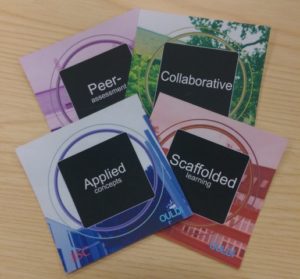 The ‘look and feel’
The ‘look and feel’
This stage of the workshop uses Course Features cards, designed by the Open University Learning Design Initiative. You’ll be asked to narrow down the features to those which are most important to the ‘look and feel’ of your course. This may sound a little ‘woolly’, but it’s an easy umbrella term for the different elements that need to be considered (pedagogic approach, guidance and support, content, interaction and so on).
As with the mission statement, this activity helps the team to work towards a consensus on the type of learning experience you want to create. But there are also other gains to this process, that sometimes go unnoticed:
- It provides a common language to help you and your colleagues talk about how you like to teach – particularly for those teaching strategies that are based on tacit experience. Choosing these stimulates discussion about them: what do you mean by …? how does that work? why is that the best approach? This discussion is useful for skill sharing and personal development, as well as narrowing down the most effective approaches for the context.
- It brings the learners into the heart of the conversation, as choices need to be made about what learning approaches they might use, and what kinds of support they might need.
- It helps to ensure that you are considering all the elements that make up a balanced course.
Constructive alignment and backwards design
 The next three sections or tasks ask you to focus in on the module level, though you will need to keep the programme-level outcomes and assessment map in the back of your mind to ensure alignment. We’ll look at the building blocks that form the basis of each module: the learning outcomes, assessment tasks and learning activities. We’ll be looking to flesh out the initial vision into a more structured pathway that is constructively aligned, asking: how do we define the learning in terms of demonstrable outcomes? how do we design assessment opportunities that allow the learner to demonstrate achievement of those outcomes? how do we create learning activities that support the learner to reach the intended outcomes and succeed in the assessment? For this we often use a ‘backwards design‘ approach, beginning with what we want the learner to know and be able to do at the end of the module, and working backwards.
The next three sections or tasks ask you to focus in on the module level, though you will need to keep the programme-level outcomes and assessment map in the back of your mind to ensure alignment. We’ll look at the building blocks that form the basis of each module: the learning outcomes, assessment tasks and learning activities. We’ll be looking to flesh out the initial vision into a more structured pathway that is constructively aligned, asking: how do we define the learning in terms of demonstrable outcomes? how do we design assessment opportunities that allow the learner to demonstrate achievement of those outcomes? how do we create learning activities that support the learner to reach the intended outcomes and succeed in the assessment? For this we often use a ‘backwards design‘ approach, beginning with what we want the learner to know and be able to do at the end of the module, and working backwards.
First in this sequence are the outcomes (what the student should ‘come out with’, or should know or be able to do). These are arguably the most important element of a module, and not (only) because they are required for quality assurance and benchmarking! Outcomes define the parameters of what will be covered, and help the student to understand what’s expected and what will be assessed. We will check the outcomes for each module against three key criteria: language, academic level, and relation to assessment.
Assessment activities will be chosen or reviewed to ensure validity: what’s the best way for a student to demonstrate these outcomes? We’ll also consider how to prepare the students for the assessment (in terms of process as well as content), and how to incorporate peer and self-assessment.
Finally, we’ll begin to consider what kind of learning and teaching will be needed to support the students in achieving the outcomes. We’ll cover this in more depth in the next section.
A note on paperwork: Any design change to a module needs to work within the relevant quality assurance framework. If you’re working on learning outcomes or assessments, these may already be written in your module specification, and making changes to these could require a change of approval. When designing learning activities, you’ll also need to consider the allocation of teaching, learning and assessment hours that currently make up the workload for that module (200 hours for a 20 credit module). Don’t let QA requirements stop you improving things – your Learning Designer or Embedded Quality Officer can help you to understand the requirements for any suggested changes.
This is one in a series of posts about the CAIeRO process. To see the full list, go the original post: De-mystifying the CAIeRO.
Need a CAIeRO? Email the Learning Design team at LD@northampton.ac.uk.
 CAIeRO workshops are a time-intensive activity, requiring two full days from every member of the team to be most effective. With this in mind, it’s really worth taking the time in advance to agree what the team wants to achieve in that time. The person running the CAIeRO will be a trained facilitator or Learning Designer, and they will always request a pre-CAIeRO meeting, with at least the programme and module leaders but ideally with the whole team.
CAIeRO workshops are a time-intensive activity, requiring two full days from every member of the team to be most effective. With this in mind, it’s really worth taking the time in advance to agree what the team wants to achieve in that time. The person running the CAIeRO will be a trained facilitator or Learning Designer, and they will always request a pre-CAIeRO meeting, with at least the programme and module leaders but ideally with the whole team.
In the pre-CAIeRO meeting we will cover a range of topics including:
- Background to the programme. We’ll need an idea of what the course is about, who the tutors are, who the learners are, mode of delivery etc.
- Why do you need a CAIeRO? We’ll discuss any goals or challenges identified by the programme team that need to be addressed, and also any upcoming QA processes (validation, PSR) that need to be considered.
- What do you know about CAIeRO? We’ll give you an overview of what you can expect, what’s expected of you, and the deliverables.
- What skills and resources do we have available? We’ll review what experience the team has of course design, of teaching on the course, of delivering in the chosen mode, of using NILE etc.
- Who (else) needs to be there? We need at least all the staff on the teaching team. This means those who lead and teach on the modules under review, and ideally also those who teach the other modules in that year or programme. This helps promote a consistent experience from the student perspective, and also allows the shared vision and skills developed to be disseminated to other modules where appropriate. We will also need at least one ‘reality checker’ from outside the team (more on that later). But in order to get the design right, we might also want input from other stakeholders… Students? Academic Librarian? Learning Technologist? Embedded Quality Officer? CfAP? Critical friend? External Examiner? Employer?
- Logistics. When* and where? You’ll need a room with a screen, and with tables for laying out flip chart paper. And although fun, CAIeRO can also be hard work, so don’t forget the coffee and biscuits!
Once we have all the details worked out, your Learning Designer will create a CAIeRO planner document and send out the link to it. This is a working document that we will be using throughout the process. Before the CAIeRO itself, the team can use this document to record their aims for the module, reflections on student feedback, and any ideas or resources they want to include on the day.
*Note: the two days that make up a CAIeRO do not need to be consecutive. There are benefits to keeping the two days together to maintain momentum, but it can also be helpful to leave time in between for reflection, depending on how the team works best. It is important though to put both days in the diary at the beginning. Leaving the second day to be arranged later risks leaving the work half done, despite the best of intentions…
This is one in a series of posts about the CAIeRO process. To see the full list, go the original post: De-mystifying the CAIeRO.
Need a CAIeRO? Email the Learning Design team at LD@northampton.ac.uk.
Recent Posts
- LearnTech Symposium 2025
- Blackboard Upgrade – August 2025
- H5P (HTML5 package) content types meets the needs of Jim Atkinson, Staff Development Trainer
- Blackboard Upgrade – July 2025
- StudySmart 2 – Student Posters
- NILE Ultra Course Award Winners 2025
- Blackboard Upgrade – June 2025
- Learning Technology / NILE Community Group
- Blackboard Upgrade – May 2025
- Blackboard Upgrade – April 2025
Tags
ABL Practitioner Stories Academic Skills Accessibility Active Blended Learning (ABL) ADE AI Artificial Intelligence Assessment Design Assessment Tools Blackboard Blackboard Learn Blackboard Upgrade Blended Learning Blogs CAIeRO Collaborate Collaboration Distance Learning Feedback FHES Flipped Learning iNorthampton iPad Kaltura Learner Experience MALT Mobile Newsletter NILE NILE Ultra Outside the box Panopto Presentations Quality Reflection SHED Submitting and Grading Electronically (SaGE) Turnitin Ultra Ultra Upgrade Update Updates Video Waterside XerteArchives
Site Admin

